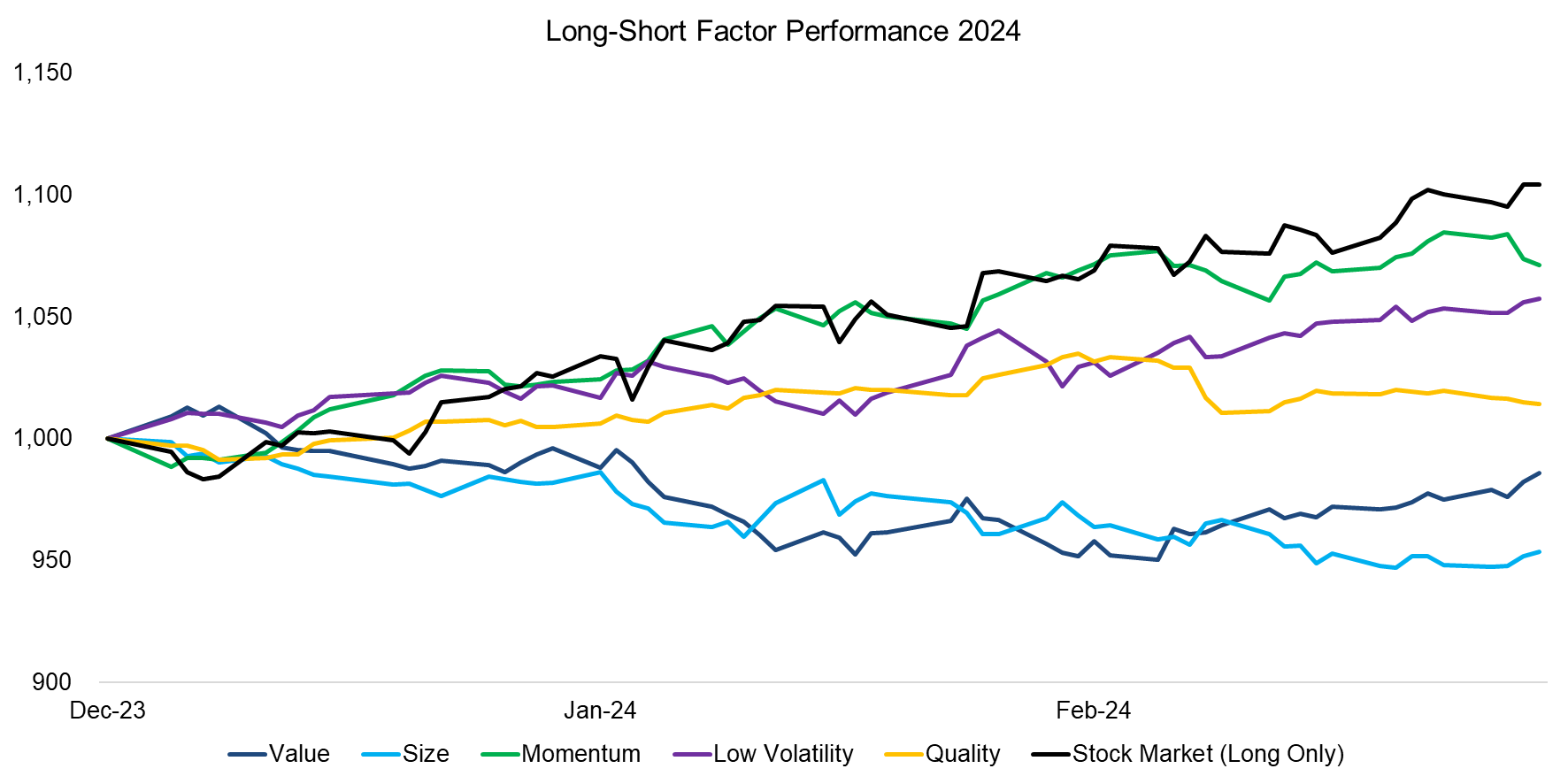Factor Olympics Q1 2024
And the winner is…
April 2024. Reading Time: 10 Minutes. Author: Nicolas Rabener.
SUMMARY
- Some factor trends continued from 2023, but there were also two significant rotations
- Momentum performed the best, size the worst
- Most long-short multi-factor products have generated positive excess returns
INTRODUCTION
We present the performance of five well-known factors on an annual basis for the last 10 years. Specifically, we only present factors where academic research supports the existence of positive excess returns across market cycles and asset classes.
METHODOLOGY
Our factors are created by constructing long-short beta-neutral portfolios of the top and bottom 30% of stocks. Only stocks with a minimum market capitalization of $1 billion are included. Portfolios rebalance monthly and transactions incur 10 basis points of costs.
FACTOR OLYMPICS: GLOBAL EXCESS RETURNS
The table below shows the long-short factor performance for the last 10 years ranked top to bottom. The global series is comprised of all developed markets in Asia, Europe, and the US. Aside from displaying the factor performance, the analysis highlights the significant factor rotation in terms of profitability from one year to the next, highlighting the benefits of diversified exposure.
We observe a continuation of last year’s trends in factor performance for the quality, value, and size factors, but also a significant rotation from being the worst- to the best-performing factors for momentum and low volatility. A theoretical portfolio providing equal-weighted exposure to all five factors would have generated 1.6% year-to-date.

Source: Finominal
TRENDS IN GLOBAL FACTOR PERFORMANCE
The trends in the factor performance were relatively consistent in the first quarter of 2024, except for quality and value. Quality stocks outperformed and value stocks underperformed in the first two months, but then trends reversed in the first week of March. It is difficult to explain these changes in investor preferences as the overall economic environment has not changed significantly during that period.

Source: Finominal
PERFORMANCE OF LONG-SHORT MULTI-FACTOR PRODUCTS
There are only a few liquid alternative mutual funds and ETFs that provide pure exposure to factors in the long-short format as seen in academic research. The last decade has seen many fund liquidations, however, Simplify Asset Management launched two new products in 2023 that provide exposure to equity and cross-asset factors, which by now have accumulated sufficient history for including them for comparative purposes.
We observe that all six products generated positive excess returns in the first quarter of 2024. Some of these products are highly correlated, eg the AQR Equity Market Neutral Fund (QMNIX) and AQR Style Premia Alternative Fund (QSPRX) feature a correlation of 0.7, while others like the Franklin Systematic Style Premia ETF (FLSP) or the Simplify Multi-Qis Alternative ETF (QIS) provide different exposures.

Source: Finominal
SMART BETA EXCESS RETURNS
Although investors should allocate to factors constructed as long-short portfolios given that these offer high diversification benefits, most invest via long-only smart beta ETFs (read Smart Beta vs Alpha + Beta). Following the money, we highlight the excess returns generated from investing in smart beta ETFs in the US, which represents a universe of 160+ products and approximately $800 billion of assets under management. We also show the performance of the growth factor, which is popular with investors but is not associated with positive excess returns over time (read What Are Growth Stocks?).
Smart beta ETFs feature approximately the same trends in excess returns as the theoretical long-short factors in year-to-date 2024. Momentum and quality stocks outperformed, while cheap and small cap stocks underperformed.
The only meaningful difference is the positive performance of the long-short low volatility factor compared to the underperformance of low volatility stocks, which can be explained by the differences in portfolio construction, namely shorting high volatility stocks, achieving beta-neutrality via leverage, and equal versus market cap-weighting for the long-short portfolio.

Source: Finominal
FACTOR CORRELATIONS
Compared to previous periods we observe no extremely positive or negative correlations in factor returns over the last 12 months. The highest correlation is between the value and low volatility factors, which implies that low-risk stocks are trading at cheap valuations and is reminiscent of the tech bubble in 2000 that featured the same constellation. Once the tech bubble imploded, these stocks outperformed significantly in the years thereafter.

Source: Finominal
FURTHER THOUGHTS
Factor investing has been written off plenty of times in the previous decade, but products such as Vanguard’s Market Neutral Fund (VMNIX) or AQR’s Equity Market Neutral Fund (QMNIX) have generated strongly positive and uncorrelated returns in each of the last four years.
Generating outperformance is hard, and is not getting easier as markets continuously become more efficient. Factor investing is still the best bet for achieving this, but is as cyclical as stock markets.
RELATED RESEARCH
The Illusion of the Small-Cap Premium
Shorting Lousy Stocks = Lousy Returns?
Higher Volatility, Higher Alpha?
Outperformance Ain’t Alpha
Improving the Odds of Value Investing
The Value Factor’s Pain: Are Intangibles to Blame?
Smart Beta vs Alpha + Beta
How Painful Can Factor Investing Get?
GARP Investing: Golden or Garbage? II
ABOUT THE AUTHOR
Nicolas Rabener is the CEO & Founder of Finominal, which empowers professional investors with data, technology, and research insights to improve their investment outcomes. Previously he created Jackdaw Capital, an award-winning quantitative hedge fund. Before that Nicolas worked at GIC and Citigroup in London and New York. Nicolas holds a Master of Finance from HHL Leipzig Graduate School of Management, is a CAIA charter holder, and enjoys endurance sports (Ironman & 100km Ultramarathon).
Connect with me on LinkedIn or X.

